There is an easy way to get close-ups by using reversible ringsand. Reversible rings are also called rolling rings.
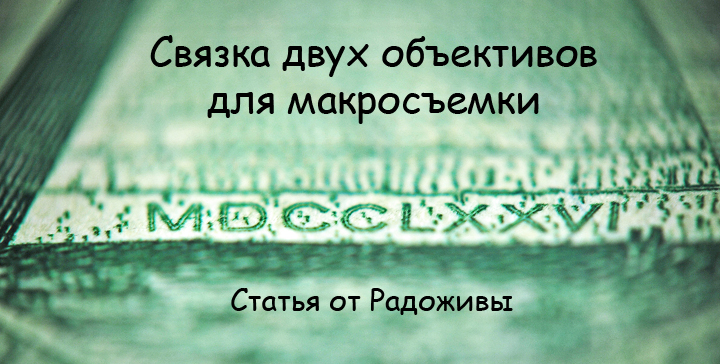
Reversible ring. The photo poster was shot just on a macro bunch of lenses.
Reversible rings should not be confused with reverse macro adapter... The reversible adapter allows one lens to be mounted backwards on the camera for macro photography. Reversible rings allow fit two lenses with their front thread.
With this docking, the reversing ring simply allows you to connect two lenses, the ring is screwed into the filter thread with one side into one lens, and the other side into the other lens, after which such a bundle is attached to the camera. It turns out that one lens works on the camera in its usual position, and the second lens works in a reversible position, since it is attached to the first one back to front. Roughly speaking, the second lens is a kind of macro lens for the first lensinstalled on the camera.
With this bunch, you can achieve very large increase. Usually, as a lens that operates in normal mode, use telephoto lens, and as the second lens attachment use fast aperture lens.
In this article, I used a Jupiter-37A 135mm F / 3.5 lens as a telephoto lens, and Helios-44-2 as a second lens attachment. To dock the lenses you just need to buy a special reversing adapter. Such an adapter can easy to do yourself with two filters. Below, I give an example of how I made myself such an adapter ring.
To begin with, I had to pull out the glass from the light filter, which served as the docking part for the Helios-44-2 lens, whose thread is 49mm.
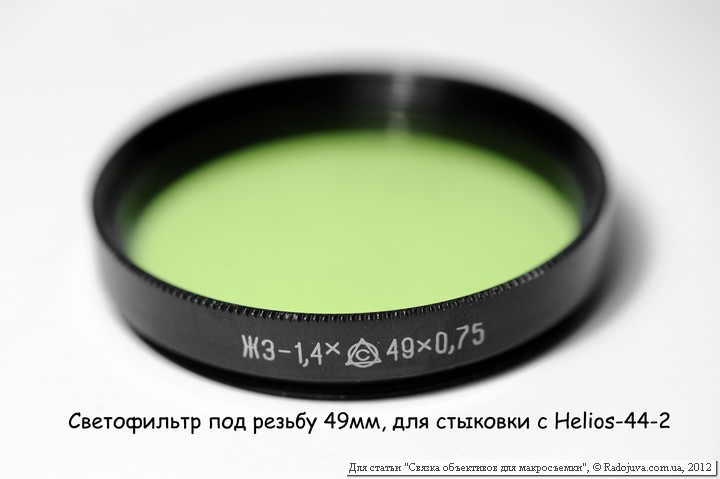
49mm thread filter
The second filter was a standard 52mm filter, since Jupiter-37A has a front filter diameter of 52mm.
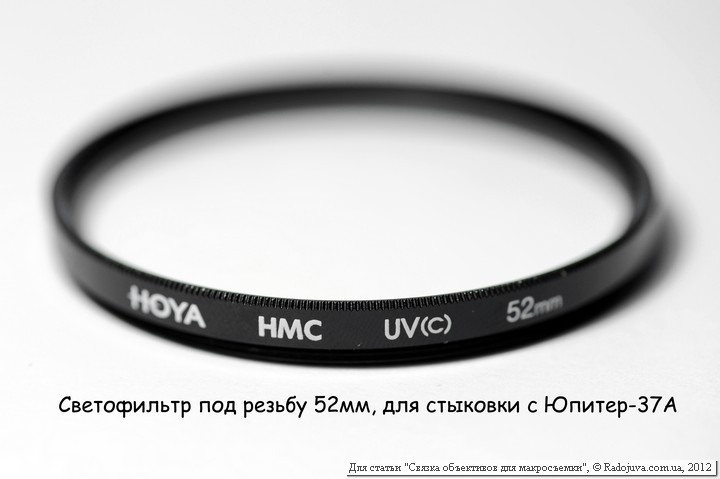
Safety filter with thread diameter 52mm
Broken glass filter view:
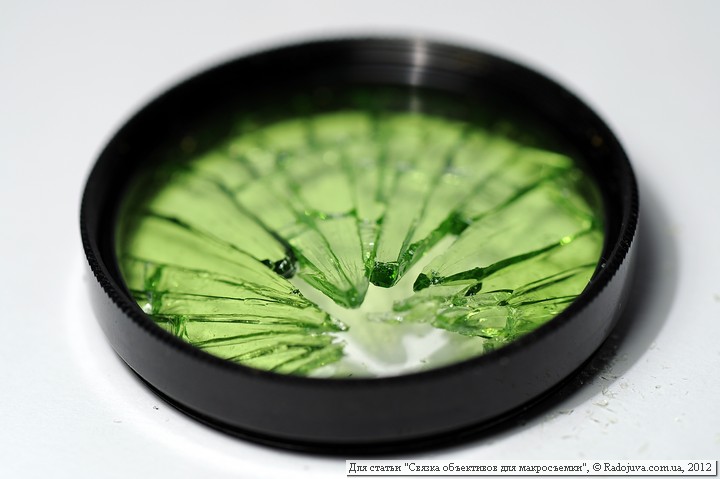
Broken glass lens view
Type of filters after removing the glasses:
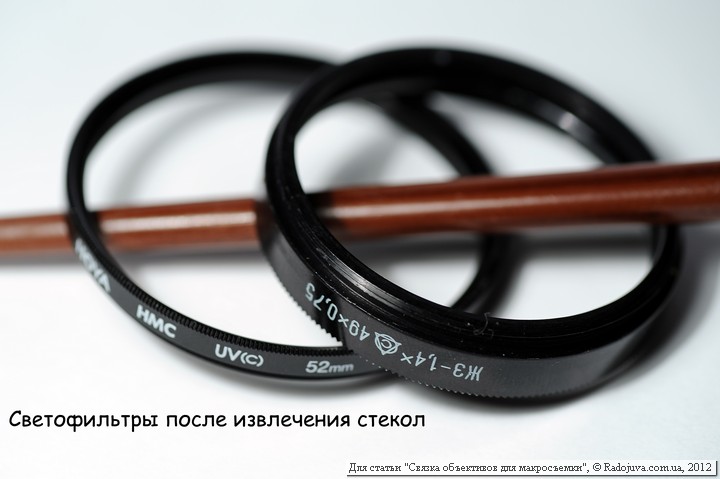
Two filters, one 49mm, the second 52mm
After that, two filters are very easy to glue with the help of super glue into the finished reverse ring:
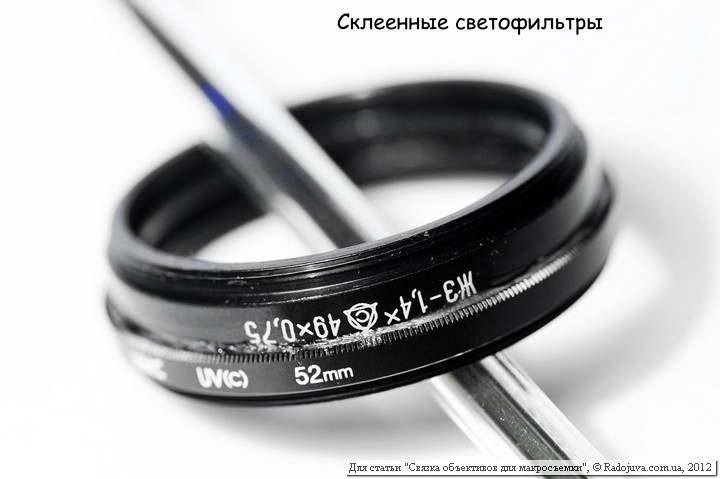
Reversible adapter
Thus, I created a reversible adapter for connecting lenses to the front thread of the filter 52mm and 49mm.
Important: when choosing a reverse ring, you need to know the diameter of the front thread of the two lenses with which you will create a bunch for macro photography. For example, in this case, the Jupiter-37A lens has a front filter diameter of 52mm, and the Helios-44-2 lens has a front filter diameter of 49mm, therefore, for the bundle you need reverse ring 49-52.
After you bought or made a reverse ring yourself, it screwed into one and second lens Is very easy to do. For example, I installed the Jupiter-37A lens on the camera, screwed the reversing ring into it, and then simply screwed the Helios-44-2 lens onto the Jupiter-37A.
After that, you can proceed to the shooting itself. True, the shooting has a number of subtleties:
- Focusing is done using the lens focus ring mounted on the camera in its normal position. If an autofocus lens is used as the primary lens, the ability to automatically focus is retained. In this case, the presence of internal focusing is very desirable.
- The depth of field control is carried out using the lens aperture device attached to the camera. If you close the diaphragm of the lens attachment, you can get the strongest vignetting.
- Such a bunch gives a strong vignetting, aperture may not help, but only enhances the vignette.
- When using manual lenses, measurement is not available on some cameras exposure and / or focus confirmation.
- This bunch of lenses is very convenient to use with a tripod in focus mode Live View.
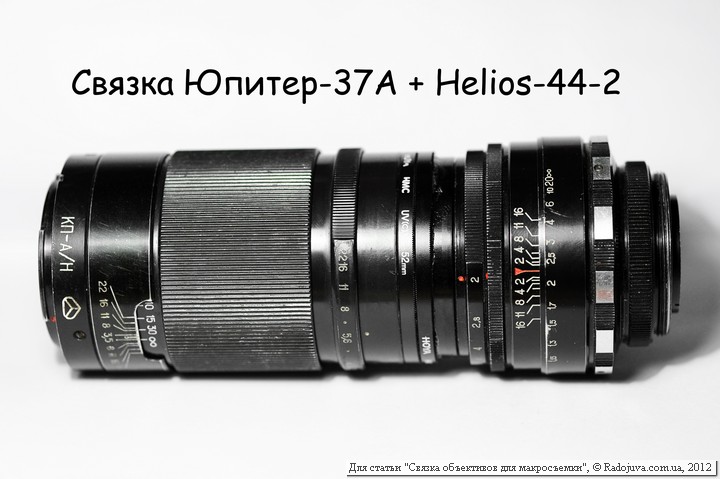
It looks like a bunch of two lenses Jupiter-337A and Helios-44-2
Here's what happens when photographing on such a bunch:
The back side of a one-dollar bill, a radiant delta.
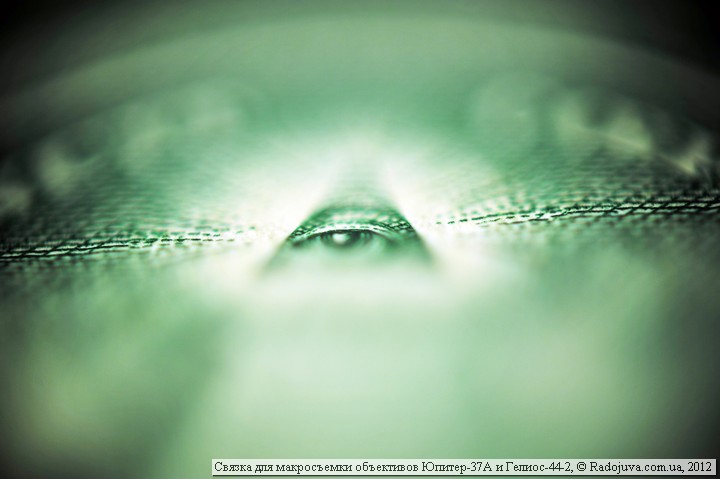
One dollar bill
With super-macro photography, you can find many amazing details, below the symbolism of the Ukrainian two hryvnia.
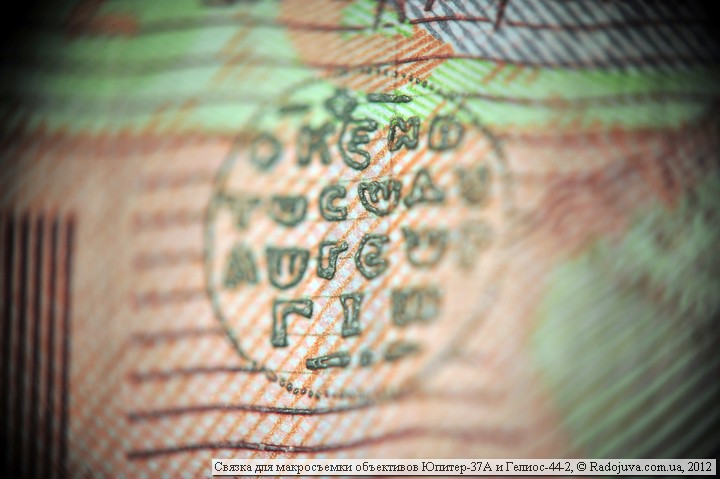
Two Ukrainian hryvnia, symbolism
The depth of field for such a survey is very, very small, the photo below was shot at an aperture value of F / 11.0
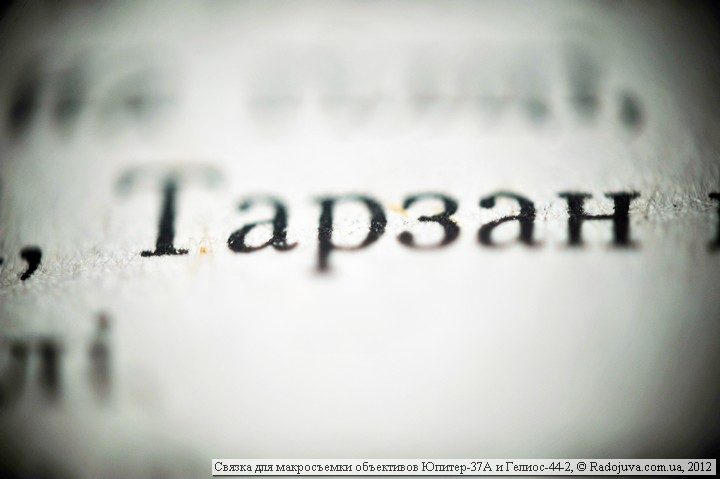
Magnification. Very shallow depth of field
If you close the diaphragm on the lens, which acts as a macro lens, you get such a circular effect:
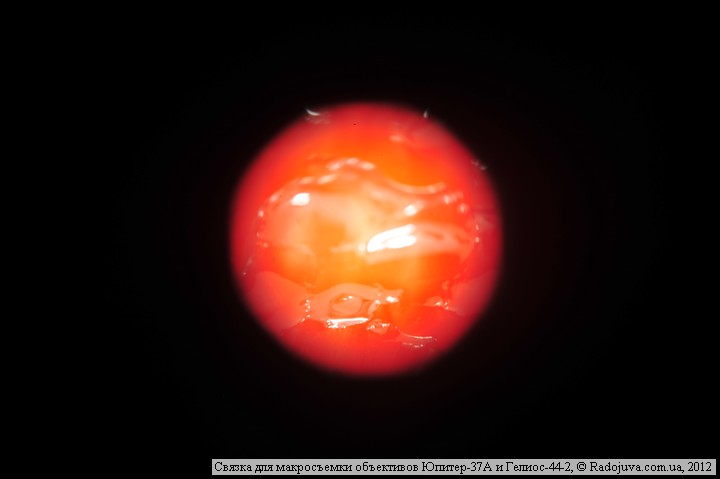
An example of a shot with a closed aperture on Helios-44-2. Grapefruit slice
In macro mode, everything looks completely different, the photo below shows the grains of rice.
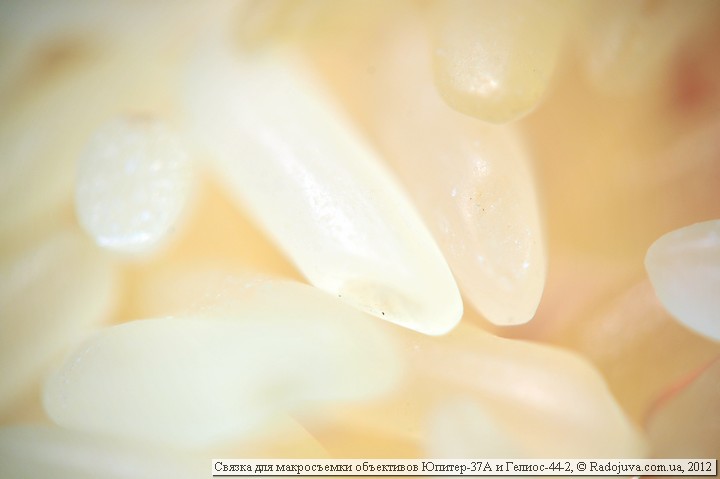
Rice grains
If in such a bundle the main lens is not telephoto, then the vignetting power increases sharply. Below is an example of a picture where a bunch of Helios-81n and Helios-44-2 was used, the first lens is a standard, not a telephoto lens.
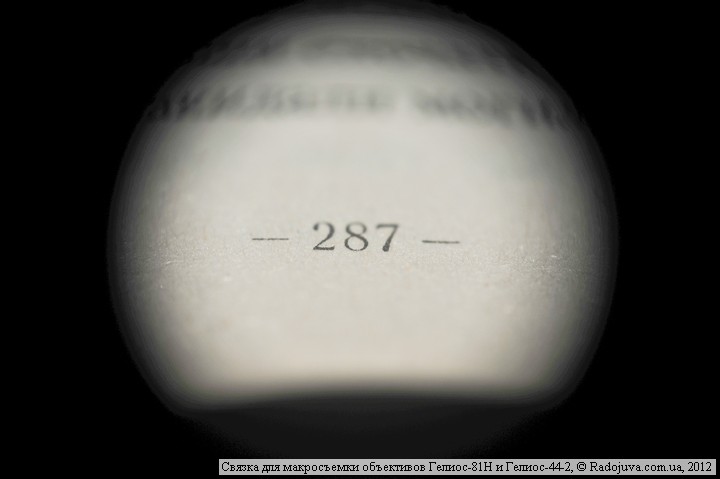
Vignetting when using short-focus lenses for a bunch.
Conclusions:
The reversible ring allows you to get macro photography with excellent magnification very cheaply. When using a reverse ring, there are some difficulties described in this article. I find the macro option more convenient with reverse macro adapter.
Help to the project. Thanks for attention. Arkady Shapoval.


At such scales, it’s much more efficient to move the subject. As in a microscope, a stage is better to have with moving screws.
Live game is usually not clicked with such a perversion.
Try a bunch of ju21 with zenithar 1.7? ..
No, I have not tried it.
GOOD DAY ARKADY - I WRITTEN TWO DAYS - BUT I MISSED MY COMMENT - ALTHOUGH I SEEN IT WITH MY OWN EYES - THAT IS NOT UNDERSTANDING AND WITH A SUBSCRIPTION TO RADOZHIVA - I WRITE A SECOND TIME)))))))
“” ”” ”” ”” ”” ”” ”” ”” ”” ””
I HAVE A CAMERA Sony a-65 - ON YOUR ADVICE, I MADE AN ADAPTER FROM LIGHT FILTERS WITH A DIAMETER OF 55 mm - to 58 mm - AND I PUT ON A LONG FOCUS LENS LIKE YOU AND WRITTEN - DIMMING LENS Sony FAMILY 70-300 SIG. IT HAS A 4mm DIAMETER AND THROUGH A MADE 5.6mm TO 58mm ADAPTER HAS BEEN CONNECTED A SONY SAL-58 55-1855 MM F / 18-55 DT SAM LENS - 3.5mm DIAMETER - BUT DOES NOT HAVE FOCUSED ON AN AUTOMATIC - NO HANDBOOK ALL OPTIONS - BOTH LENSES HAVE MANUAL FOCUS AND AUTO FOCUS - IT IS SEEKING INCREASING BUT NOT FOCUSING - PLEASE HELP PLEASE UNDERSTAND ...
Dyakuyu! Tsіkava article! Yak zavdi, Škoda is true, but for the purpose of eliminating your fellow, you had a chance to beat the filter :(. Having experienced such a principle for macro, aly winn’t doesn’t matter; as well as the photographer’s coma is pretty good, the depth is good (I want a minimum of F8), then it’s all varied. I’m very happy with macro lenses + Pentacon 50 mm / 1.8 x Jupiter-9 85 mm -2.0А 37 mm f / 135 in the bedding of the near-needed scale macro, fragments of chim mensha Focal vіdstan obєktiva іz markokіltsyami tim bіlshy vihodit macro scale. takozh Je tsіkavy factor scho vikoristovuyuchi dovgofokusnі obєktivi (napriklad Jupiter-3.5A 37 mm f / 135) mozhna znіmati komah іz dosit velikoї vіdstanі :) Vikoristovuvav maximum of 3.5 makrokіlets іz obєktivom. Woke up to finish the tsikavo http://ua.photoclub.com.ua/_/599083.jpeg?0
coolooo.
I am muting the standard set of macrokilets + U9 + u51. Macro - microscope. I without extras, more than a bunch of burgundy .. Shaw really indstar 51 I just squeezed in front of the scale of Jupiter 9 (screwed on a macro-coil in the chamber), moreover, the natural growth of diameters is also great. I think it’s through that retail space, which is wider, but it’s easy to place the weight on its surface, and the photos were viewed by them, on any meaning.
ps I don’t viklada’s photos, I’m more screwed up.
Experiment with the diameters yourself ...;)
because I’m mav on uvazі50 (small one). everywhere, de porvtikav i writing i3.5 ..
Pentacon of wide format technology kіltsya?
Very interesting. Now we need to buy broken filters.
Soviet filters cost 5 kopecks per bucket.
Old color filters for film cameras cost a penny, so go ahead)))
I just used such a filter.
Great, thanks.
It's my pleasure :)
Great article! Super macro! There is no adapter, I will have time to try manually just leaning 2 lenses against each other. One lens will stand on the camera (nikon 18-55), and the second I will simply lean against it manually - Helios 81H. I wonder what will happen ... And will it work at all))
Where can I find these color filters for film cameras?
Arkady, by the way, did you try to take a picture in this bundle somehow, so that the depth of field was wider? And then it's so thin ... Although this subtlety has its own charms)
The depth of field is controlled by the diaphragm, I did not imprint the data about the diaphragm this time, since I did not record them elementarily. With Kitov and Helios will be as shown in the last photo.
DOF is very small, do not pervert. Focusing in such a bundle is more convenient when moving the subject. On the mirrors, by the way, this method of shooting is not very effective. The most spectacular results are obtained when using heavily cropped matrices. For example, this is the Panasonic FZ8 + Helios 44 http://img-fotki.yandex.ru/get/6610/51459081.1/0_720dd_30be3df0_XL.jpg http://img-fotki.yandex.ru/get/6610/51459081.1/0_720da_55936a56_XL.jpg
By the way, yes, my examples for the full frame were shot, on the crop the vignette will be smaller and the increase larger.
An interesting article, informative.
Such an interesting vignette turns out, it can be used for creative ideas :).
I knew about this method of macro photography, but did not try, because so far they are arranging macro rings or macromechs.
I also tried with a reversible adapter and one Helios 81 lens, but the results were not impressive, yet the depth of field is not enough for me. So for now, I see the best alternative to use macromech, and a lens with a small MDF and the ability to close the aperture well, at least up to 22.
Fifty dollars usually close the diaphragm to 16.
Now I’ve found a real find for the subject - World 3B, it loses a bit to fifty dollars in resolution, a little against 40 against 50 lines in the center, I don’t notice by eye, but its aperture is 22 against 16, and MDF 40 mm against 50, and focal 65 versus 50. You can achieve greater depth of field with a smaller distance to the object. 10 cm objects are obtained for the entire frame.
Yes, one of the options has a small MDF https://radojuva.com.ua/2012/09/obzor-mir-3v-3-5-65mm/
If you use autofocus as the first lens (the one that is put on the carcass), then auto focus will work. On Demiart, in the MACRO section, recently posted photographs taken in this way.
My article is written for this.
Sori, I read very quickly, did not notice ...
OFFOPT: The blog does not have enough email alerts about new comments and replies, the Subscribe To Comments plugin implements this functionality perfectly.
There will be time, I’ll finish it.
Here is the result of using the FUJI s5600 + Helios 44 bundle: http://img-fotki.yandex.ru/get/4132/193995926.0/0_b6cbf_4ee02360_orig , http://img-fotki.yandex.ru/get/4132/193995926.0/0_b6cbd_2227d15f_orig , http://img-fotki.yandex.ru/get/4117/193995926.0/0_b6cbe_789ca43b_orig
Good result
Have you flipped one lens? Used not a bunch of two lenses? and another question you ordered a reverse ring?
On ebay, Chinese reversible rings are for $ 2 and this is taking into account delivery with any variations in diameters ...
Extremely helpful article! Thank you very much. I just liked Jupiter-37A, and for Helios 44-2 they are cheaply asking, but I did not know where to apply it.
With such a combination, it is logical to use macro rails and a stack. A stack is when several dozen photos are taken with the focus point moving forward all the time, and then using the stack program, these photos are collected into one file with normal sharpness across the entire field of the frame.
And the Chinese macro rails on the sites are not expensive to sell.
And how can the ratio be calculated? Somewhere it happened that if the telefocus is 150mm, and the fifty-fifty is then 50mm, the macro ratio will be 3: 1, is that so?
The increase depends not only on the focal length, but also on the MDF and the size of the matrix (film).
In my opinion, the game is not worth the candle. Much more effective - shirik on the wraparound ring.
How's that?
Thanks!! need to play
You can make the design easier.
Helios 44-2 is pretty squeezed and held in the hood of Jupiter, no adapters needed
Tell me, please, there is a reversing ring, the Nikon camera, twisted, but everything is dark in the lens, autofocus is disabled, pictures are not obtained, i.e. no image, only blurry everything is obtained.
It would be nice if they indicated the model of the device and lens :)
nikon 5000, Full-time lens 18-105.
Through the reverse ring, everything is like a rainbow, and muddy
From 18-105, using a reversing adapter is very problematic, since the iris will always be closed at f / 22-36.
So, this is a matter of the lens ((I read that some do not manually open the diaphragm somehow.
Using the aperture lever on the rear end of the lens, finding it is easy.
two fifty dollars, aperture four, removed the vignette in the editor.
http://cs408226.vk.me/v408226672/230/bIu5GcpHZ5Y.jpg
A 50mm nikkor with Helios 44-2 will be able to connect?
nikkor auto 55-200 with 50 f / 1.2 manual I want to try to knit ... will it work?
Defechka liked the spiders, I wanted to take a picture))))) I don’t know the current, how to turn and twist the lens)))))
Interesting article. Thank you, Arkady. I have the experience of connecting two rangefinder lenses to make a super macro: first I connected Industar-61l / d through an adapter m39-nikon with a carcass. From the damaged FED-5V I unscrewed the threaded part for mounting the lens, then screwed I96U from it Tavriya put the enlarger into the front of the Industar-61l / d. It holds tight, but for reliability it is better to stick it. The result is an excellent super-macro, also very light and compact.
Very informative, but insects with such a focusing distance cannot be captured. I used the following bundle for sony alpha 450. I took a 75-300 telephoto lens, removed the front lens and instead screwed Jupiter 37A into the thread through an adapter. The result is a telemacro with a focusing distance of 35-45 cm and an increase of 0.5 - 2. The design drawback is the weight and vignette at low magnification. It would be interesting to know your opinion on this method of macro shooting. I forgot to add a very decent depth of field and can still be added by closing the aperture of the front lens. Sincerely.